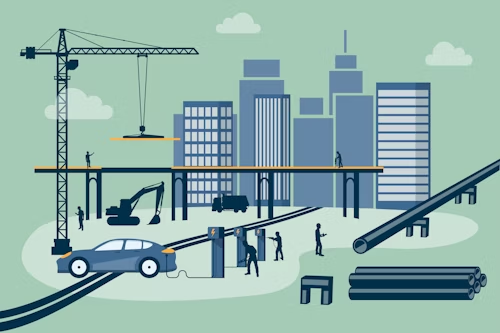Why Urban Investment Needs a Reset
In many cities, investment skips the people who need it most. Developers build high-rises downtown but leave broken homes in low-income areas untouched. This gap in effort has real effects. Empty homes become crime magnets. Broken sidewalks keep seniors indoors. Poor lighting leads to unsafe streets.
A report from the U.S. Department of Housing and Urban Development shows that over 17 million U.S. households live in homes that are physically inadequate or cost too much. In cities like Baltimore, there are 15,000+ vacant properties, many in the same neighborhoods year after year. These blocks don’t need new stadiums or luxury towers. They need trust—and the kind that comes with real work, not just big talk.
The Problem with Traditional Development
Too often, developers show up, build fast, and leave even faster. They focus on short-term gains. They buy low, flip fast, and ignore the long-term effects. That cycle doesn’t build trust. It breaks it.
“I’ve walked into homes with roofs falling in and neighbors watching from porches,” said Timur Yusufov. “And the first thing they ask is, ‘Are you going to sell it to someone else who won’t live here?’ That says everything.”
When a community feels like a business plan instead of a place to live, people stop trusting. They stop expecting things to get better. And when hope disappears, investment stops working.
What Trust Looks Like on a Block
Trust shows up in small things. A fixed sidewalk. A front porch that doesn’t lean. A landlord who answers calls. A builder who listens.
It also shows up in big things. Long-term rentals instead of quick flips. Local hiring instead of outside contractors. Projects designed for families—not just young professionals with remote jobs.
“We fixed up one house and added a ramp,” Yusufov shared. “A neighbor walked over and said her mom hadn’t left the house in weeks because of the stairs. That one ramp changed how two families saw their block.”
That’s what trust feels like. Real impact. Not just ROI.
The New Model: Invest, Stay, Repair
Here’s what a better model of urban investment looks like. It’s not flashy. But it works.
Step 1: Fix Before You Build
Before pouring concrete, look at what’s already there. Does the street flood when it rains? Are there trees blocking light at night? Is the school nearby walkable?
Start by fixing what’s broken. People notice. That builds momentum. That builds trust.
Step 2: Work With the Community
Talk to the people who live there. Not after the permits are approved—before. Ask what they need. A better floor plan? More storage? Safer lighting?
“We started putting large kitchen spaces in because families told us they eat together,” Yusufov said. “You don’t get that kind of feedback from a spreadsheet.”
Step 3: Use Long-Term Materials
Don’t patch a wall that’ll crack in a year. Use quality, durable materials. Think about energy savings, water use, and accessibility.
According to the National Renewable Energy Laboratory, energy-efficient upgrades can lower household bills by $500 to $1,200 annually. That’s real money in a working family’s pocket.
Step 4: Build to Stay, Not Just Sell
Don’t just build for the buyer. Build for the block. Keep some properties as rentals. Partner with nonprofits for affordable housing. Show you’re committed.
“The idea is simple,” Yusufov said. “If I wouldn’t let my own family live there, it’s not ready.”
Step 5: Make It Walkable
Walkability builds community. Make it easy to walk to the store, the bus stop, the park. Fix sidewalks. Add lighting. Partner with local artists for murals and public spaces.
The Trust for Public Land found that residents living near well-maintained parks report 25% higher satisfaction with their neighborhoods. Public space matters.
Data That Backs It Up
- One in four renters spends over half their income on housing (Harvard Joint Center for Housing Studies, 2023)
- 80% of low-income renters have no savings for emergency repairs or relocations
- Crime drops by 21% when vacant homes are maintained (University of Pennsylvania, 2022)
- Energy-efficient housing reduces monthly costs and improves indoor health, especially in children and seniors
These numbers aren’t trends. They’re signs. Urban investment that fixes problems, includes people, and plans ahead is safer, smarter, and more effective.
What Cities and Investors Can Do Next
Cities:
- Offer grants for small-scale repairs, not just major builds
- Speed up permits for community-led projects
- Support land trusts and affordable housing co-ops
- Track investor behavior to spot patterns of absentee ownership
Investors:
- Keep units affordable through shared equity or capped rent increases
- Commit to maintaining properties for 10+ years
- Hire and train local workers
- Be transparent about plans with the community
Community Leaders:
- Partner with developers who are willing to stay
- Host neighborhood input sessions before development begins
- Push for infrastructure repairs alongside housing
- Use local data to track health, safety, and trust improvements over time
Building a Block Is Building a Future
There’s no fast fix for rebuilding trust. But there is a clear path. It starts with steady work, honest conversations, and projects that put people first. You don’t need a billion-dollar fund to make a street feel safe again. You just need to care enough to stay after the paint dries.
Timur Yusufov’s model proves it’s possible. He didn’t build towers. He built trust—one block at a time.
It’s time more developers, investors, and leaders followed that plan. Not just to grow profits. But to grow places people actually want to call home.

